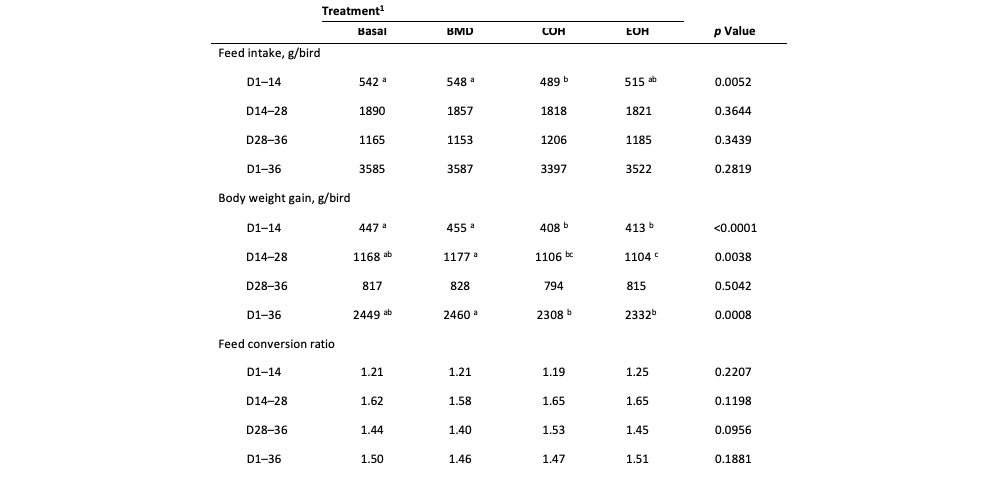


 Français
Français


To preserve the potency of clinically important antibiotics, there has been a gradual reduction of the use of preventative antibiotics in food- producing animals. An alternate strategy to prevent disease in broiler chickens is to promote gut health through the feeding of high fiber ingredients, such as oat hulls (OH). Dietary fibers fuel the activities of beneficial bacteria resulting in the production of short-chain fatty acids (SCFA) which lower the gut pH and inhibit the growth of pathogenic bacteria (Cherrington et.al. 1991). As well, the type of fiber has an impact on blood chemistry with soluble fiber being shown to reduce the concentrations of sugars, lipids and cholesterol in the blood (Brown et al., 1999). Coarse OH are very high in lignin and insoluble fiber. Extrusion is a processing technique combining high pressure with high temperatures and can modify the fiber fractions in feed ingredients. A previous study by Dr. Adewole et al. (2020) showed that the inclusion of 3% fine particle-sized OH had the potential to enhance growth performance and carcass weight of broiler chickens while free choice feeding of OH did not.
To determine the effect of dietary supplementation with coarse and extruded OH on growth performance, blood biochemistry and gut health in broiler chickens.
This research demonstrates that coarse or extruded oat hulls may improve gut health with no negative impact on production performance. This could be a low- cost tool for producers to incorporate into their management practices as they move towards the removal of preventative use antibiotics.
Groups of 26 mixed sex Ross 308 broiler chickens were assigned to 24 pens. There were four dietary treatments randomly assigned to each pen. The dietary treatments consisted of a corn-soybean meal-wheat based diet (Basal), Basal diet + Bacitracin methylene disalicylate (BMD), an anti-bacterial indicated for the prevention and control of enteritis, increased rate of weight gain, and improved feed efficiency, Basal + 3% coarse OH (COH), and Basal + 3% extruded OH (EOH). The birds were fed using a phase-feeding program that consisted of starter phase (d 0 to 14), grower phase (d 14 to 24) and finisher (d 24 to 39). Diets were fed in pelleted and crumbled form during the starter phase and in pelleted form during the grower and finisher phases. Body weight and feed intake were determined on a pen basis on d 8, 15, 22, 28 and 36. On d 36, one chicken was randomly selected from each pen and euthanized. Blood samples were collected, weights of the empty gizzard and ceca, the bursa of Fabricius and spleen were determined, and digesta from the ceca was collected. The following parameters were determined: feed intake, body weight, body weight gain, feed conversion ratio, organ weights, concentration of SCFAs, blood chemistry and identification of gut microbiota.

References
Adewole et al., Effect of Oat Hulls Incorporated in the Diet or Fed as Free Choice on Growth Performance, Carcass Yield, Gut Morphology, and Digesta Short Chain Fatty Acids of Broiler Chickens. Sustainability 2020, 12, 3744.
Brown et al., Cholesterol-lowering effects of dietary fiber: A meta- analysis. Am. J. Clin. Nutr. 1999, 69, 30–42.
Cherrington et al., Short-chain organic acids at pH 5.0 kill Escherichia coli and Salmonella spp. without causing membrane perturbation. J. Appl. Bacteriol. 1991, 70, 161–165.
Sacranie, A. 2017. The relationship between feed particle size, gizzard size and broiler performance. Zootechnica International April Edition.
Van der Klis et al., Energy in poultry diets: Adjusted AME or net energy. Proc. Aust. Poult. Sci. 2010, 21, 44–49.
Funding
Canadian Agricultural Partnership – Advancing Agricultural Research and Innovation Initiative, Chicken Farmers of Nova Scotia and Dalhousie University
The full publication of this work can be found online.
Adapted from the Atlantic Poultry Research Institute’s Factsheets
PO Box 550 Truro, NS B2N 5E3 (902) 893-6657
Laurie.Eagles@dal.ca www.APRinstitute.ca

